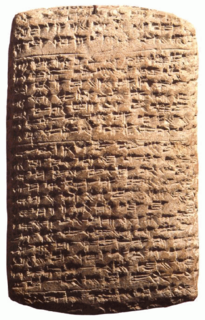Related Research Articles

The Amarna letters are an archive, written on clay tablets, primarily consisting of diplomatic correspondence between the Egyptian administration and its representatives in Canaan and Amurru during the New Kingdom, between c. 1360–1332 BC. The letters were found in Upper Egypt at el-Amarna, the modern name for the ancient Egyptian capital of Akhetaten, founded by pharaoh Akhenaten (1350s–1330s BC) during the Eighteenth Dynasty of Egypt. The Amarna letters are unusual in Egyptological research, because they are mostly written in a script known as Akkadian cuneiform, the writing system of ancient Mesopotamia, rather than that of ancient Egypt, and the language used has sometimes been characterised as a mixed language, Canaanite-Akkadian. The written correspondence spans a period of at most thirty years.

The land of Subartu or Subar is mentioned in Bronze Age literature. The name also appears as Subari in the Amarna letters, and, in the form Šbr, in Ugarit.

Rib-Hadda was king of Byblos during the mid fourteenth century BCE. He is the author of some sixty of the Amarna letters all to Akhenaten. His name is Akkadian in form and may invoke the Northwest Semitic god Hadad, though his letters invoke only Ba'alat Gubla, the "Lady of Byblos".
Zimredda , also Zimr-Edda or Zimr-Eddi was the mayor of Siduna, in the mid 14th century BC. His name means, "Protection/Protector" Hadad, "(My) protector (is) Hadad", "The protector is Hadad", "Protector-Hadad", etc. He is mentioned in several of the Amarna letters, in the late Rib-Hadda series, and later. He authored letters EA 144–45.
Adda-danu was the 'mayor' of the city/city-state of Gazru-(modern Gezer, Israel) of the Amarna letters period, 1350-1335 BC. 'Adda' is the name of the Northwest Semitic god Hadad, and Adda-danu translates as: "Hadad Judge". Adda-danu is one of the three mayors who ruled Gazru in the 20–year Amarna letters correspondence, the others being Milkilu, and Yapahu.
Pahura, and also spelled Pihur/Pihuru, Pihura, and Pihuru/Pihure was a commissioner of the 1350 BC Amarna letters correspondence. Pahura's name means in Egyptian, ' the Syrian ' , and he was commissioner to the Egyptian pharaoh.
Šuwardata, also Šuardatu, (Shuwardata) is understood by most scholars to be the king of the Canaanite city of Gath, although some have suggested that he was the 'mayor' of Qiltu, during the 1350-1335 BC Amarna letters correspondence. Šuwardata was the author of 8 letters to the Egyptian pharaoh.

Pawura, and also: Pauru, Piwure, Puuru/Puwuru was an Egyptian official of the 1350-1335 BC Amarna letters correspondence. As mentioned in letter no. 171, he was also an Egyptian "archer–commander". In letter no. 289 he is called an "irpi–official". In Egyptian his name means 'the Great One', (Pa-wr/Pa-ur)(letter EA 287:45-"1.-Pa-Ú-Ru")
Milkilu, and more properly Milk-ilu, or Milku-ilu, with an alternate version of Ili-Milku, was the mayor/ruler of Gazru (Gezer) of the 1350–1335 BC Amarna letters correspondence. Adda-danu, and Yapahu were also mayors of Gazru.
Yapa-Hadda, also Yapah-Hadda, was the mayor/ruler of Biruta-(Beirut) of the 1350-1335 BC Amarna letters correspondence.
Amanmašša is the name of an Egyptian official, but probably two separate officials-(?), in the |1350-1335 BC Amarna letters correspondence. The Egyptian form of his name is Amenmose, which means "Amun-born".
Haapi, also Haip and Ha'ip was a commissioner of the 1350-1335 BC Amarna letters correspondence. The name "Hapi" in Egyptian is the name for the Nile god Hapi.
Ili-Rapih was the follow-on mayor in Gubla-(modern Byblos), and the brother of Rib-Hadda, the former mayor of Gubla, ; Ili-Rapih is in the 1350-1335 BC Amarna letters correspondence, and wrote 2 follow-on letters to the Pharaoh after the death of Rib-Haddi.
Yidya, and also Idiya, was the Canaanite mayor/ruler of ancient Ašqaluna/Ashkelon in the 1350-1335 BC Amarna letters correspondence.
Irimayašša, or Iriyamašša was an Egyptian official, of the 1350-1335 BC Amarna letters correspondence, written from a 15-20 year time period. The 2 letters that reference him are regarding Byblos/Gubla, and Ashkelon/(Ašqaluna), in western and southwestern Canaan.

The Salhi is a region/city-state in the vicinity of Ugarit during the 15-20 year Amarna letters correspondence of 1350-1335 BC.

Amarna letter EA 86,, titled: Complaint to an Official, is a somewhat moderate length clay tablet letter from Rib-Hadda of city-state Byblos to Amanappa, an official at the court of the Pharaoh.

Amarna letter EA 271, titled: "The Power of the 'Apiru," is a moderately, short, tallish, rectangular clay tablet letter, approximately 3 in wide x 4 in tall, from Milkilu the mayor/ruler of Gazru (Gezer), of the mid 14th century BC Amarna letters.

Amarna letter EA 270, titled: "Extortion," is an ovate-shaped, medium-sized, tall letter, approximately 3 in wide x 4 in tall, from Milkilu the mayor/ruler of Gazru (Gezer), of the mid 14th century BC Amarna letters.

Amarna letter EA 362, titled: "A Commissioner Murdered," is a finely-inscribed clay tablet letter from Rib-Haddi, the mayor/'man' of the city of Byblos,. Byblos, being a large coastal seaport Mediterranean city, was a city that was aligned with Egypt (Miṣri), and housed an Egyptian community. Rib-Haddi, as the city-state leader wrote the largest number of letters to the Pharaoh, in a sub-corpus of the 1350 BC Amarna letters.
References
- Moran, William L. The Amarna Letters. Johns Hopkins University Press, 1987, 1992. (softcover, ISBN 0-8018-6715-0)
| This Ancient Near East-related article is a stub. You can help Wikipedia by expanding it. |
| This Ancient Egypt biographical article is a stub. You can help Wikipedia by expanding it. |